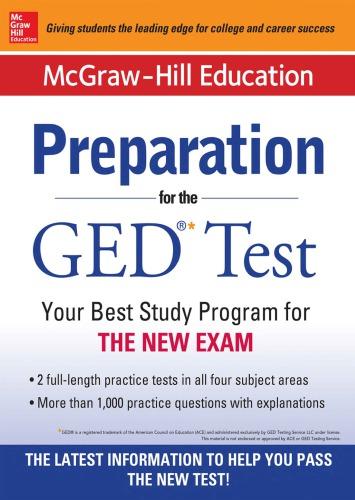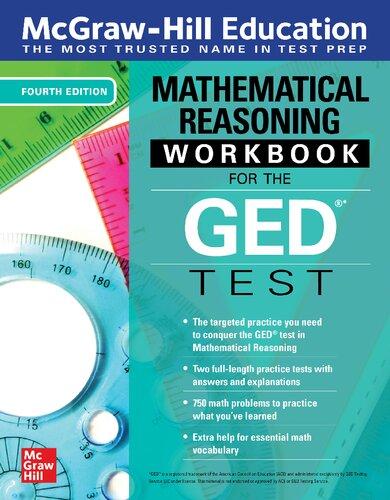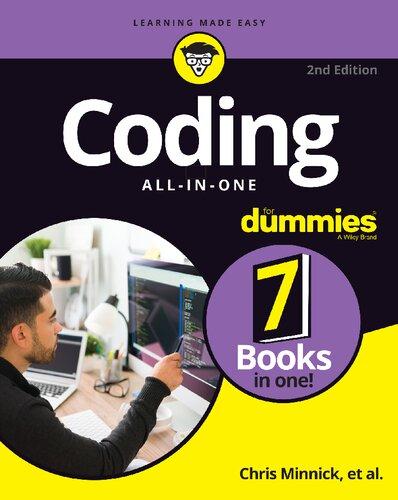A Few Assumptions
When we wrote this book, we made a few assumptions about you, dear reader. Here’s who we think you are:
» You’re serious about earning your GED as quickly as you can.
» You’ve made earning a GED a priority in your life because you want to advance in the workplace or move on to college.
» You’re willing to give up some activities so you have the time to prepare, always keeping in mind your other responsibilities, too.
» You meet your state’s requirements regarding age, residency, and the length of time since leaving school that make you eligible to take the GED test. (You can find these on the GED Testing Service’s website, ged.com.)
» You have sufficient English language skills to handle the test (or sufficient Spanish language skills if you take the test in Spanish).
» You want a fun and friendly guide that helps you achieve your goal.
If any of these descriptions sounds like you, welcome aboard. We’ve prepared an enjoyable tour of the GED test.
Icons Used in This Book
Icons — little pictures you see in the margins of this book — highlight bits of text that you want to pay special attention to. Here’s what each one means:
Whenever we want to tell you a special trick or technique that can help you succeed on the GED test, we mark it with this icon. Keep an eye out for this guy.
This icon points out information you want to burn into your brain. Think of the text with this icon as the sort of stuff you’d tear out and put on a bulletin board or your refrigerator.
Take this icon seriously! Although the world won’t end if you don’t heed the advice next to this icon, the warnings are important to your success in preparing to take the GED test.
We use this icon to flag example questions that are much like what you can expect on the actual GED test. So if you just want to get familiar with the types of questions on the test, this icon is your guide.
Beyond the Book
For some helpful advice to prepare for and succeed on the GED, check out the online Cheat Sheet. Just go to www.dummies.com and type in “GED Test For Dummies Cheat Sheet” in the search box.
In addition to all of the tips, study aids, and practice that this book provides, you can go online and work through three full-length practice tests. All you have to do is register by following these simple steps:
1. Register your book or ebook at Dummies.com to get your PIN. Go to www.dummies.com/ go/getaccess.
2. Select your product from the dropdown list on that page.
3. Follow the prompts to validate your product, and then check your email for a confirmation message that includes your PIN and instructions for logging in.
If you do not receive this email within two hours, please check your spam folder before contacting us through our Technical Support website at http://support.wiley.com or by phone at 877-762-2974.
Now you’re ready to go! You can come back to the practice material as often as you want. Simply log on with the username and password you created during your initial login. No need to enter the access code a second time.
Your registration is good for one year from the day you activate your PIN.
Where to Go from Here
Some people like to read books from beginning to end. Others prefer to read only the specific information they need to know now.
Chapter 1 starts off with an overview of the GED test and how to register for the exam. For those less comfortable with computers, Chapter 2 provides a lot more detail about the computerized GED test and what computer basics you need to know. If you want an overview of the different types of questions and how you can prepare for those subjects, check out Chapter 3. Chapter 4 gives you plenty of hands-on material to help you leading up to and the morning of test day, including what to do right before the test starts.
The chapters in Parts 2, 3, 4, and 5 go into detail about each of the test sections, starting with Reasoning through Language Arts, then Social Studies, Science, and finally Mathematical Reasoning. In each of those parts, you can find an introduction to the specific test section, along with question types and solving strategies, and some practice questions. When you’re ready to dive into full-length practice tests that mimic the real GED test, check out Parts 6 and 7 and then check your answers with the detailed answer explanations we provide for each test section. (Just be sure to wait until after you take the practice test to look at the answers!)
What to Expect: The Testing Format
There are two options for taking the GED. You can take the GED at a testing center or online at home. (The GED Testing Service calls the at-home version the “online-proctored” GED.) Either way, a computer administers the GED test. That means that all the questions appear on a computer screen, and you enter all your answers into a computer. You read, calculate, evaluate, analyze, and write everything on the computer, including rough math calculations or outlining your essay. Instead of paper, the test centers provide you with an erasable tablet, or you use an onscreen whiteboard.
If you know how to use a computer and are comfortable with a keyboard and a mouse, you’re ahead of the game. If not, practice your keyboarding. Also, practice reading from a computer screen because reading from a screen is very different from reading printed materials. At the very least, you need to get more comfortable with computers, even if that means taking a short course at a local learning emporium. In the case of the GED test, the more familiar you are with computers, the more comfortable you’ll feel taking the test.
If you have a special need, you are also covered. The GED offers accommodations so that all testtakers have a fair chance. You can indicate that you need accommodations when you open your account on ged.com, or later, by updating your profile.
Throughout this book, you see references to the GED Testing Service’s website, ged.com. It’s a great repository of information, learning aids, and online practice tests. It’s also where you sign up to take the test. If you don’t have an account there, now is a good time to open one. Just go to ged.com, select Sign Up, and follow the prompts.
The GED test provides speedy, detailed feedback on your performance. When you pass (yes, I said when and not if, because I believe in you), the GED Testing Service provides both a diploma and a detailed transcript of your scores, similar to what high school graduates receive. These are now available in your online account at ged.com within a day of completing the test. You can then send your transcript and diploma to an employer or college. Doing so allows employers and colleges access to a detailed outline of your scores, achievement, and demonstrated skills and abilities. This outline is also a useful tool for you to review your progress. It highlights those areas where you did well and areas where you need further work. If you want to (or have to) retake the test, your score report will provide a detailed guide to what you should work on to improve your scores. Requests for additional copies of transcripts are handled online and also are available within a day.
Reviewing the Test Sections
The GED test includes the following four sections (also referred to as tests), each of which you can take separately:
» Reasoning through Language Arts
» Social Studies
» Science
» Mathematical Reasoning
You can take each of the four test sections separately, at different times, and in any order you want. You can also take some of them online at home and others at a testing center. This flexibility is one of the benefits of doing the test by computer. Because everyone is working individually on the various test sections rather than as a group, the computer-based test eliminates the need for the whole group of test-takers to work in tandem. For example, you may be working on the Mathematical Reasoning test, while your neighbor is working on the Social Studies test. Just don’t look around at all your neighbors to verify this because proctors may think you’re doing more than satisfying your curiosity.
The following sections offer a closer look into what the test sections cover and what you can expect.
Because the GED tests are always evolving, be sure to check out the latest and greatest about the GED program at ged.com
Reasoning through Language Arts test
The Reasoning through Language Arts (RLA) test is one long test that covers all the literacy components of the GED test. You have 150 minutes overall. However, the test is divided into three sections: first, you have 35 minutes of reading comprehension questions, then 45 minutes for the Extended Response (essay), followed by a 10-minute break, and then another 60 minutes for grammar and language questions. Remember that the time for the Extended Response can’t be used to work on the other questions in the test, nor can you use leftover time from the other sections on the Extended Response.
Here’s what you can expect on the RLA test:
» The reading component asks you to demonstrate a critical understanding of various passages.
» The Extended Response item, also known as “the essay,” examines your skills in organizing your thoughts and writing clearly. Your response will be based on one or two source text selections, drawing key elements from that material to prepare your essay.
The essay is evaluated both on your interpretation of the source texts and the quality of your writing. You type on the computer, using a tool that resembles a word processor. It has neither a spell-checker nor a grammar-checker. How well you use spelling and grammar as you write is also part of your evaluation. You’ll have an erasable tablet and/or an onscreen whiteboard on which to write notes or an outline before writing your essay on the computer.
» The grammar and language component asks you to correct errors in various kinds of texts. This includes demonstrating a command of proper grammar, punctuation, and spelling.
» The scores from all three components will be combined into one single score for the RLA test.
The question-answer part of this test consists mainly of various types of multiple-choice questions and drop-down menu questions with four answer choices. You’ll also see drag-and-drop questions. For details on the different question types, see Chapters 2 and 3.
The questions are based on source texts, which are materials presented to you for your response. Some of this source material is nonfiction, from science and social studies content as well as from the workplace. Only 25 percent is based on literature. Here’s a breakdown of the materials.
» Workplace and community materials: These include work-related letters, memos, and instructions that you may see on the job. They also include letters and documents from companies and community organizations, such as banks, hospitals, libraries, credit unions, and local governments.
» U.S. founding documents and documents that present part of the Great American Conversation: These may include extracts from the Bill of Rights, the Constitution, and other historical documents. They also may include opinion pieces on relevant issues in American history and civics.
» Informational works: These include documents that present information (often dry and boring information), such as the instructional manual that tells you how to set the clock on your DVD player. They also include materials that you may find in history, social studies, or science books.
» Literature: These include extracts from novels and short stories.
See Chapter 3 for a more detailed overview of the RLA test. Chapters 6 and 7 give the lowdown on both the reading comprehension questions and the grammar and language questions. I devote two whole chapters (Chapters 8 and 9) to helping you with the essay. For practice, see Chapters 19 and 27 for two complete Reasoning through Language Arts tests, with answers and explanations in Chapters 20 and 28. I also provide a third, complete online-only test. Check out Chapter 2 for the format of the questions as they appear on the computer.
Social Studies test
The Social Studies test is scheduled for 70 minutes for the 50 questions. On this test, you will see standard multiple-choice questions, as well as fill-in-the-blank questions, drag-and-drop questions, and drop-down menu questions. A few questions may ask you to calculate an answer. In this case, a calculator icon will appear on your test screen, or you can bring your TI-30XS MultiView calculator if you test at a test center. In Chapter 3, you can see examples of these questions.
The questions are based on various kinds of source texts. About half of the questions are based on one source text, such as a graph or short reading, with one question. Other questions have a single source text as the basis for several questions. In either case, you’ll need to analyze and evaluate the content presented to you as part of the question. A few questions may ask you to compare and contrast information from two different sources. The test questions evaluate your ability to use reasoning and analysis skills. The information for the source materials comes from primary and secondary sources, both text and visual. That means you need to be able to “read” and interpret tables, maps, and graphs as well as standard text materials.
The content of the Social Studies test is drawn from the following four basic areas.
» Civics and government: The largest part (about 50 percent of the test) focuses on civics and government. The civics and government questions examine the development of democracy, from ancient times to present day. Other topics include how civilizations change over time and respond to crises.
» American history: American history makes up 20 percent of the test. It covers all topics from the pilgrims and early settlement to the Revolution, the Civil War, World Wars I and II, the Vietnam War, and current history — all of which involve the United States in one way or another.
» Economics: Economics make up about 15 percent of the test. The economics portion examines basic theories, such as supply and demand, the role of government policies in the economy, and macro- and microeconomic theory.
» Geography and the world: This area also makes up 15 percent of the test. The areas with which you need to become familiar are very topical: sustainability and environmental issues, population issues, and rural and urban settlement. Other topics include cultural diversity and migration.
A good way to prepare for this test is to read as much as possible. As you prepare for the test, read articles about civics, history, economics, and geography from reliable online sources. Even reading solid news coverage can help you develop the strong reading skills you need. See Chapters 10, 11, and 12 for detailed coverage on how to prepare for the Social Studies test. Chapters 21 and 29 give you two complete Social Studies tests, with complete answers and explanations in Chapters 22 and 30. I also provide a third, complete online-only test. See Chapter 2 for the format of the questions as they appear on the computer.
Science test
The Science test is scheduled for 90 minutes. My advice for the Science test is the same as for the Reasoning through Language Arts test: read as much as you can, especially science material. Whenever you don’t understand a word or concept, look it up in a dictionary or online. The questions in the Science test assume a high school level of science vocabulary.
You don’t have to be a nuclear physicist to answer the questions, but you should be familiar with the vocabulary normally understood by someone completing high school. If you work at improving your scientific vocabulary, you should have little trouble with the Science test. (Note: That same advice applies to all the GED test’s sections. Improve your vocabulary in each subject, and you’ll perform better.)
The Science test concentrates on two main themes:
» Human health and living systems
» Energy and related systems
In addition, the content of the test focuses on the following areas.
» Physical science: About 40 percent of the test focuses on physics and chemistry, including topics such as conservation, transformation, and flow of energy; work, motion, and forces; and chemical properties and reactions related to living systems.
» Life science: Another 40 percent of the Science test deals with life science, including biology and, more specifically, human body and health, relationship between life functions and energy intake, ecosystems, structure and function of life, and molecular basis for heredity and evolution.
» Earth and space science: This area makes up the remaining 20 percent of this test and includes astronomy — interaction between Earth’s systems and living things, Earth and its system components and interactions, and structure and organization of the cosmos.
Go ahead and type one of the three areas of content into your favorite search engine to find material to read. You’ll find links to articles and material from all different levels. Filter your choices by the level you want and need — for example, use keywords such as “scientific theories,” “scientific discoveries,” “scientific method,” “human health,” “living systems,” “energy,” “the universe,” “organisms,” and “geochemical systems” — and don’t get discouraged if you can’t understand technical material that one scientist wrote that only about three other scientists in the world can understand.
The questions on the Science test are in multiple-choice, fill-in-the-blank, drag-and-drop, and drop-down menu formats. As on the Social Studies test, you will read passages and interpret graphs, tables, and other visual materials. A few questions may ask you to calculate an answer. For these questions, a calculator icon will appear on your test screen or you can use your own TI-30XS MultiView calculator if you test at a test center.
See Chapters 13, 14, and 15 for detailed coverage on how to prepare for the Science test. Chapters 23 and 31 give you two complete Science tests, with complete answers and explanations in Chapters 24 and 32. I also provide a third, complete online-only test. See Chapter 2 for the format of the questions as they appear on the computer.
Mathematical Reasoning test
The Mathematical Reasoning (Math) test checks that you have the same knowledge and understanding of mathematics as a typical high school graduate. Because the GED is designed to prepare you for both postsecondary education and employment, it has an emphasis on both workplace-related mathematics and academic mathematics. About 45 percent of the test is about quantitative problem solving, and the rest is about algebra.
The Math test consists of different question formats to be completed in 115 minutes. Because the GED test is administered on the computer, the questions take advantage of the power of the computer. Some questions will simply pose a problem for you to solve. Other questions will refer to various kinds of stimulus materials, including graphs, tables, menus, price lists, and much more. Check out Chapters 2 and 3 for more information and a sneak peek at what the questions look like onscreen.
The following are the types of questions that you’ll encounter in the Math test.
» Multiple-choice: Most of the questions in the Math test are multiple-choice with four answer choices.
» Drop-down: This type of question is a form of multiple-choice in that you get a series of possible answers, one of which is correct. The only difference is that you see all the options at once within the text where it’s to be used. For examples, see Chapters 2 and 3.
» Drag-and-drop: This question type asks you to arrange information in a certain way by clicking and dragging it on your screen. For example, you may be asked to order a list of positive and negative fractions, decimals, and numbers in order from lowest to highest.
» Fill-in-the-blank: In these questions, you have to provide an answer. The fill-in-the-blank questions are straightforward: You’re asked for a very specific answer, either a number or one or two words, and you type the answer into the space provided.
Some questions may be stand-alone with only one question for each stimulus. Others may have multiple questions based on a single stimulus. Each stimulus, no matter how many questions are based on it, may include text, graphs, tables, or some other representation of numeric, geometrical, or algebraic materials. Practice reading mathematical materials and become familiar with the vocabulary of mathematics. As on the Social Studies and Science tests, you will have available an onscreen calculator, or you can bring your own TI-30XS MultiView calculator. On the Math test, you are allowed to use your calculator on all but the first five questions. However, some questions can be answered more quickly using mental math or simple calculations on the whiteboard.
See Chapters 16, 17, and 18 for detailed coverage of the Math test. Chapters 25 and 33 give you two complete Math tests, with complete answers and explanations in Chapters 26 and 34. I also provide a third, complete online-only test. See Chapter 2 for the format of the questions as they appear on the computer.
It’s a Date: Scheduling the Test
You book your appointment through the GED Testing Service’s website, ged.com, based on available testing dates. Because a computer administers the test, you will schedule an individual appointment. Your test starts when you start and ends when the allotted time ends. If you sign up to take the test online at home, your computer and your home (or other location where you take the test) have to meet special requirements outlined when you sign up. The ged.com website will walk you through these requirements. If you sign up to take the test at a testing center, you will take the test in a computer lab, often containing no more than 15 seats; testing facilities may be located in many communities in your state.
At the time of publication of this edition of GED For Dummies, 5th Edition, some states — Indiana, Iowa, Louisiana, Maine, Missouri, Montana, New Hampshire, New York, Tennessee, and West Virginia — don’t offer the test. You can take the test in a neighboring state that allows nonresidents to test. Just select the state you’d like to test in when you set up your online account. This information changes periodically, so be sure to check ged.com/state-information-onlinetesting for the latest information. And remember: nearly all employers and higher education schools nationally accept your passing score.
The following sections answer some questions you may have before you schedule your test date, including whether you’re eligible to take the test, when you can take the test, and how to sign up to take the test.
Determining whether you’re eligible
Before you schedule your test date, make sure you meet the requirements to take the GED test. You’re eligible to apply to take the GED test only if
» You’re not currently enrolled in a high school. If you’re currently enrolled in a high school, you’re expected to complete your diploma there. The purpose of the GED test is to give people who aren’t in high school a chance to get an equivalent high school diploma.
» You’re not a high school graduate. If you’re a high school graduate, you should have a diploma, which means you don’t need to take the GED test. However, you can use the GED to upgrade or update your skills and to prove that you’re ready for further education and training.
» You meet state requirements regarding age, residency, and the length of time since leaving high school. When you open your online account at ged.com, the software will screen you to ensure you meet your state’s requirements.
Knowing when you can take the test
You can take the GED test when you’re eligible and prepared. You can then apply to take the GED test as soon as you want. Pick a day (or days) that works for you. If you want to take the test online at home, you must pass the GED Ready® practice test before you can sign up. Even if you are taking the test at a test center, this short online test can help you determine whether you are likely to be successful. This can help you avoid wasting time and money on retests. And if you don’t pass, the detailed feedback will help you find your strengths and areas for improvement.
ARE SPECIAL ACCOMMODATIONS AVAILABLE?
If you have a special need, it can be accommodated. Remember, though, that if you request an accommodation, you will need to provide acceptable documentation.
The GED Testing Service makes every effort to ensure that all qualified people have access to the tests. If you have a disability, you may not be able to register for the tests and take them the same week, but, with some advanced planning, you can probably take the tests when you’re ready. Here’s what you need to do:
• Review the information and instructions at https://ged.com/about_test/accommodations/
• At least a month before you want to take the test, go to ged.com and open an online account, or log into an existing account.
• Follow the instructions to request an accommodation. The software will walk you through the steps to request an accommodation and submit the proper documentation.
• You will need documentation of your special need from an appropriate professional. The software will give the exact requirements and instructions you can show the professional so they can provide the correct documentation.
• Complete all the proper forms and submit them with a medical or professional diagnosis.
• Start planning early so that you’re able to take the tests when you’re ready.
The GED Testing Service defines specific disabilities, such as the following, for which it may make special accommodations:
• Learning and cognitive disorders (LCD)
• Attention deficit/hyperactivity disorder (ADHD)
• Psychological and psychiatric disorders (EPP)
• Physical disabilities and chronic health conditions (PCH)
Taking all four sections of the GED test together takes about seven hours. However, the test is designed so that you can take each section when you’re ready. In fact, you can take the test sections one at a time, in evenings or on weekends, depending on the individual testing center. You can also take some of the tests at a testing center, and others at home. If you pass one test section, that section of the GED test is considered done, no matter how you do on the other sections. If you fail one section, you can retake that section of the test. At the time of the publication of this book, there are limits on the frequency at which you can retake the test online at home. That’s why the GED Ready practice test is required — if you pass it, you will likely pass the real test.
Because the test starts when you’re ready and finishes when you have used up the allocated time, you can take it alone and don’t have to depend on other people. This offers great flexibility in scheduling the test, especially when testing online at home. When you sign up for the test, you can search for times and locations that suit you.
If you need special arrangements to accommodate your situation, the GED Testing Service will help arrange the test for you at a convenient time and location.
Taking the GED Test When English Is Your Second Language
The good news is that English doesn’t have to be your first language for you to take the GED test. In the United States, the GED test is offered in English and Spanish. A French version is available in Canada.
If English (or Spanish) isn’t your first language, you must decide whether you can read and write English or Spanish as well as or better than 40 percent of high school graduates. If so, then you can prepare for and take the test without additional language preparation. If you don’t read or write English or Spanish well enough to pass, then you need to take additional classes to improve your language skills until you think you’re ready. Your local community college or adult education center is the best place to get started. Your account at ged.com can also help you find local programs that will suit your needs.
GETTING MORE INFORMATION ABOUT THE GED TEST
There are plenty of resources for getting more information about the GED. The first place to start is the GED Testing Service’s website, ged.com. In addition to the information offered there, you will find many other ways to get additional information. There are links to several blogs where you can submit questions directly to GED staff. You can also communicate via online chat or send an email to help@ged.com. And if you need to talk to a real person, you can call their toll-free number, 1-877-EXAM-GED (1-877-392-6433).












